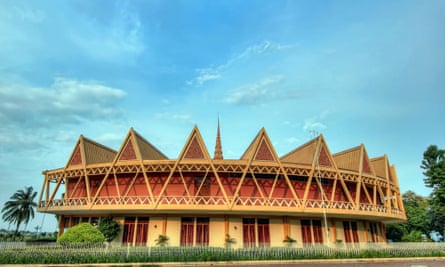The architect Vann Molyvann, who has died aged 90, was often described as “the man who built Cambodia”. In the 1960s he transformed Cambodia’s capital, Phnom Penh, from a colonial backwater into one of the most beautiful and innovative of south-east Asian cities. Drawing inspiration from the ancient bas-reliefs and designs of the Angkor Wat temple complex, Vann’s style, which came to be known as New Khmer architecture, blended Khmer tradition with the modernist principles he had mastered during studies in Paris.
After Norodom Sihanouk abdicated from the Cambodian throne in 1955 in order to enter politics, and became prime minister, he launched a programme of cultural revival, educational expansion and economic development, with Vann in charge of urban planning. The architect’s most famous works in Phnom Penh included the lotus-shaped Independence Monument, the National theatre, the Chaktomuk conference hall, and the National Sports Complex, also known as the Olympic Stadium (though it never hosted the event).

More than 100 Vann projects – monuments, villas, the Royal University of Phnom Penh, public housing projects and the port of Sihanoukville – were constructed between 1956 and 1970. Others in the region watched with a mixture of curiosity and envy. In 1967, Singapore’s prime minister Lee Kuan Yew led a delegation to Phnom Penh and was so impressed that he asked Sihanouk if he could hire Vann to help plan a new Singapore. He was politely turned down.
Vann did not simply erect the new and tear down the past. “Modernity should not be inspired superficially by western ideas that destroy all trace of the past,” he said. “New building should bring tradition and heritage back to life.” The era was dubbed Cambodia’s “golden age”, with new movements not only in architecture, but also in music, film, dance and art.
The Olympic Stadium, seating 60,000 people, opened in 1964. A moat around the perimeter prevented flooding during the monsoon season, an acute problem in low-lying Phnom Penh. Vann told one French architect: “Cambodia is a society of half-earth, half-water. Cities should not be built by landfill but by incorporating water into their design.” It was environmental planning and eco-friendly architecture far ahead of its time.

The architect Helen Grant Ross, co-author of Building Cambodia: New Khmer Architecture 1953-70, told me: ‘‘When foreign architects or organisations like Unesco discover Vann Molyvann’s buildings, they can’t believe that they were built by a Cambodian. To me he was a great architect, and if he had been a European he would have been world famous.”
Son of Vann Uk and Quam Pik, Vann was born to a poor family in Kampot province, south-west Cambodia, when it was still a French protectorate. He won a scholarship to study law in France, but switched to architecture studies at the Ecole Nationale Supérieure des Beaux-Arts in Paris. He worked as an architect in Paris for two years, 1954-56. When he returned to Cambodia, which had gained independence in 1953, he was made chief architect by Sihanouk.
Phnom Penh’s status as a potential Asian model city was brutally stopped in its tracks by a US-backed military coup led by General Lon Nol in 1970 that drew Cambodia into the Vietnam war and led to the rise of the Khmer Rouge. Vann took refuge in Switzerland. For the next 20 years, he worked as an architect and as a consultant for the UN Habitat and Human Settlements Foundation.
In the early 90s, with Cambodia under the supervision of a UN mission, he returned to Phnom Penh. His urgent priority was to secure World Heritage status for the long-neglected wonders of Angkor Wat and this was awarded in 1992. Vann also became chief of Apsara, the conservation authority for the Angkor temple complex.

Angkor Wat and other great temples could be restored, but the spirit and politics of the 60s could not. Sihanouk returned home, but no longer at the helm of state: his coronation as a constitutional king under the 1993 constitution left him without any political power. The new “coalition” government of Hun Sen and the king’s son Prince Norodom Ranariddh was far more interested in foreign investment, and tourist income, than in implementing conservation rules and no-go commercial development zones close to Angkor. In 2001 Vann was removed from his Apsara assignment.
Phnom Penh inevitably turned into a chaotic sprawl of high-rise buildings that hungrily devoured green spaces and demolished colonial heritage buildings: not even Vann’s creations were spared. He looked on with sadness when his much-cherished stadium was sold to a Taiwanese company, which proceeded to fill up its hydraulic system of moats and water treatment stations with new construction. However, other key parts of his legacy have survived to inspire a new generation of architectural students.
Vann never stopped his research and his advocacy. His book Modern Khmer Cities (2003) outlined water management programmes for Sihanoukville, Siem Reap City and Phnom Penh, taking into account their unique geography and river flows. He was made a commandeur of the Légion d’Honneur, and in 2013, he was awarded a Nikkei Asia prize for culture.
He is survived by his wife, Trudy (nee Amberg), three daughters and two sons. His eldest son predeceased him.

Comments (…)
Sign in or create your Guardian account to join the discussion